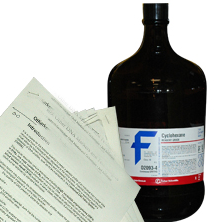Archival Notice
This is an archive page that is no longer being updated. It may contain outdated information and links may no longer function as originally intended.
Home | Glossary | Resources | Help | Contact Us | Course Map
A written Hazard Communication Program (HazCom) is a necessity for any laboratory that deals with chemicals. The purpose of the Hazard Communication Program is to document the receipt, storage, use, and disposal of chemicals within the laboratory. Often, the HazCom Program is part of the laboratory's Chemical Hygiene Plan, but may exist as a stand-alone program. See OSHA standard 29 CFR 1910.1200 Hazard Communication.
Read more about the HazCom standard on the OSHA website.
The Hazard Communication Program should include the following components:14
- Procurement of hazardous chemicals
- Purchasing may have to be reviewed and approved by the Safety Officer and/or the laboratory's governing agency's safety group.
- Material Safety Data Sheets (MSDS) should be reviewed before procuring chemicals new to the laboratory.
- Material Safety Data Sheets - View the Material Safety Data Sheet.
- The written Hazard Communication Program should include instructions on how to review and evaluate the MSDS for chemicals used in the laboratory in order to appropriately evaluate the chemicals' hazard.
- Personal Protective Equipment
- The Hazard Communication Program may be the area where the Safety Officer chooses to address personal protective equipment (PPE) and the evaluations of tasks that require PPE.
- Chemical Inventory
- The laboratory should have a complete and accurate chemical inventory. Local fire departments and municipal environmental programs offices will deem it necessary to create and maintain an accurate chemical inventory. A yearly audit of the chemicals and storage conditions should also be a part of the inventory.
- Chemical Labeling and Storage
- The program should also include labeling requirements that ensure that all chemical- containing products are labeled in compliance with OSHA Hazard Communication standards. The standard requires:
- Name of the product matching the MSDS
- Manufacturer's name, address, and phone number
- Appropriate hazard warnings including target organ effects
- If the chemical is transferred to a smaller container, each container must be appropriately labeled
- The program should also include labeling requirements that ensure that all chemical- containing products are labeled in compliance with OSHA Hazard Communication standards. The standard requires:
- Training
- The intent of the OSHA HazCom standard is to ensure that employees are aware of safety issues regarding chemicals that are being used in the workplace BEFORE work commences. It is therefore the responsibility of the employer to provide HazCom training to new laboratory employees before they are assigned to work with hazardous chemicals.
- Training should include:
- Methods and observations that may be used to detect the presence of a hazardous chemical.
- The hazards involved with the chemicals present in the workplace.
- The measures employees can take to protect themselves against the chemical hazards present in the workplace.
- Explanations on how employees can obtain and use chemical hazard information (labeling system, MSDS).
Additional Online Courses
- What Every First Responding Officer Should Know About DNA Evidence
- Collecting DNA Evidence at Property Crime Scenes
- DNA – A Prosecutor’s Practice Notebook
- Crime Scene and DNA Basics
- Laboratory Safety Programs
- DNA Amplification
- Population Genetics and Statistics
- Non-STR DNA Markers: SNPs, Y-STRs, LCN and mtDNA
- Firearms Examiner Training
- Forensic DNA Education for Law Enforcement Decisionmakers
- What Every Investigator and Evidence Technician Should Know About DNA Evidence
- Principles of Forensic DNA for Officers of the Court
- Law 101: Legal Guide for the Forensic Expert
- Laboratory Orientation and Testing of Body Fluids and Tissues
- DNA Extraction and Quantitation
- STR Data Analysis and Interpretation
- Communication Skills, Report Writing, and Courtroom Testimony
- Español for Law Enforcement
- Amplified DNA Product Separation for Forensic Analysts


